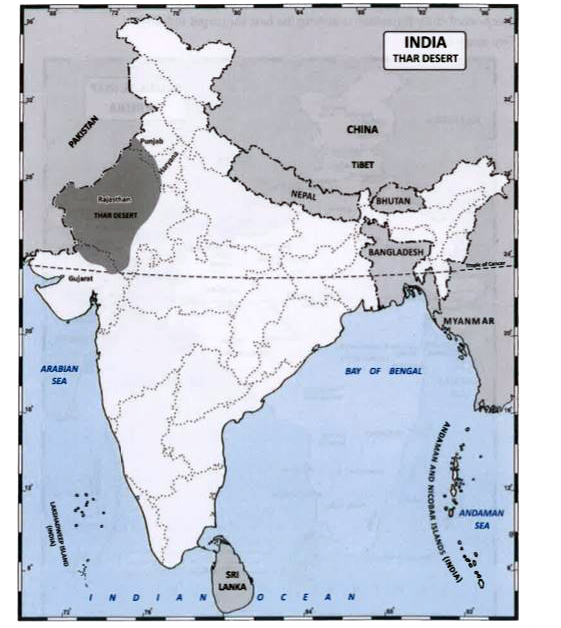The map given below illustrates the Thar Desert, also known as the Great Indian Desert. As the map represents, it is a large and completely dry region in the northwestern part of the Indian subcontinent. It covers an area of 200,000 km and forms a natural boundary between India and Pakistan. The Thar Desert is the 17th largest desert, and the world's 9th largest sub-trogpcal desert. About 85 percent of the Desert is located within India. The remaining 15 percent of the Desert is in Pakistan. Even in India, more than 60 percent of the Thar Desert lies in the Indian state of Rajasthan. From Rajasthan it extends into the states of Gujarat, Punjab and Haryana. In Pakistan it lies in the provinces of Sindh and Punjab.

Text Solution
The Thar extends between the Aravalli Hills in the north-east and the great rann of Kutch along the western coast. Most of the desert area is covered by huge shifting sands. The Luni River is the only river integrated into the desert. Rainfall is quite less 100-500 mm per year. Salt water lakes abound in Rajasthan and Gujarat. The most famous is the Sambhar Lake in Rajasthan. The salt is derived by the weathering of rocks in the region. The soil is prone to wind erosion. The 649 km. long Indira Gandhi Canal bring fresh water to the Thar. Acacia, Cassia and Jojoba are the main species of trees grown here. The region faces frequent droughts. Agriculture production is mainly from Kharif crops like bajra, pulses, guar, jowar, maze, sesame and groundnuts. Certain areas like Farilka in Punjab and Shri Ganga Nagar in Rajasthan are rich in cotton crops. Farmers depend on animal husbandry for their livelihood. Cows, buffalo, sheep, goats, camels and oxen are among the major cattle population. The sheep-wool from Rajasthan is among the best for carpet industry.
|
Updated on:21/07/2023
Related Playlists
- BOOK - FULL MARKSCHAPTER - COMPOSITION - II (WRITING ANALYTICAL PARAGRAPH ON MAP/CHART/REPORT/ LINE GRAPH)EXERCISE - ANALYTIC STUDY OF REPORTS3videos
COMPOSITION - II (WRITING ANALYTICAL PARAGRAPH ON MAP/CHART/REPORT/ LINE GRAPH)
- BOOK - FULL MARKSCHAPTER - CLOZE PASSAGEEXERCISE - Fill in the most appropriate option in each blank from those given below to complete the following passage.112videos
CLOZE PASSAGE
- BOOK - FULL MARKSCHAPTER - COMPOSITION-IEXERCISE - IV. OFFICIAL LETTERS ON ALL SITUATIONS (SOLVED EXAMPLES)29videos
COMPOSITION-I
Similar Questions
The Indian Desert
View SolutionWhich is the largest desert in the world?
View Solution_________ is the largest desert in the world.
View SolutionThe Thar Desert, also known as the Great Indian Desert, lies towards the western margins of hills.
View SolutionGreat Victoria desert in located in
View SolutionWhich is the world's largest desert ?
View SolutionWhich is the world's largest desert ?
View SolutionThe major river in the Thar Desert is
View SolutionWrite short note on the Indian Desert.
View SolutionSahel' region of Sahara desert is associated with
View Solution

